Green .
Green was Viet Nam’s first colour. Before the people, the culture, the languages, the cities; there was a green covered land. Alive and bright with the vegetation and botantic scents. It was a colour of renewal and regrowth.
That changed soon enough and the colour green came to symbolise more.
Two hundred Vietnamese solders and I visited Ho Chi Minh’s Mausoleum one day. I might have stood out slightly.
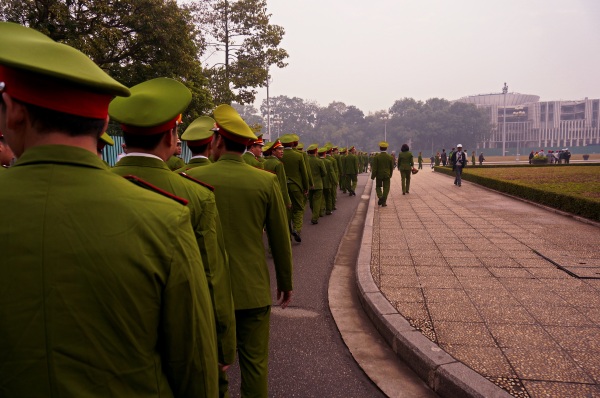
A vibrant green of a banana (chuối) plantation, nestled in a mountain valley. The landscape was as beautiful and serene as I was hot and sweaty. The ideal growing conditions for bananas are not the ideal conditions for a hike.

Getting covered in vines and moss is just part of getting older for Viet Nam’s ancient buildings.

Rice waiting to be harvested. I was waiting for the rain and cool change promised by the clouds.

I ordered this drink because it was called Cóc* and I childish thought it would be funny to order. The joke was on me. It was just terrible, undrinkable. The radioactive green colour should have been my first warning.
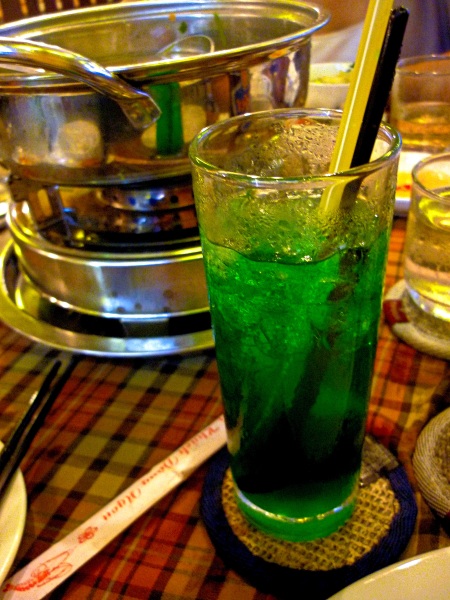
Eventually the vegetation will take what was once their’s. There are already some temples that are succumbing.
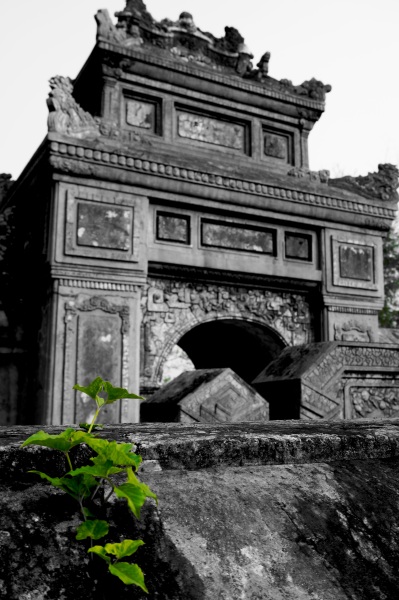
*This is a drink called Nước Cóc. Nước means ‘water’ or ‘juice,’ while Cóc means ‘frog.’ A Cóc is also a small green fruit that is the same size, shape and colour as a tree frog. This drink was made with fake Cóc, as always, real Cóc is best.Posted in Asia, Colour, Culture, Expat, Photography, Viet Nam, VietnamTagged Asia, Color, Colour, Expat, Green, Soldiers, Viet Nam, Vietnam6 Comments
Banal cruelty
Every society and culture has different ideas about an animal’s purpose and treatment. In Viet Nam, a dog’s purpose can range from a treasured family member* to a source of meat. Eating dogs is slowly being unpopular, but there is still an average of 5 million dogs killed for their meat every year.** Dog meat is a more commonly eaten in the north, so I rarely see it here in the south. That isn’t to say that I haven’t seen dog carcasses in the markets; their fur burnt off, their blacked lips stretching their mouths into a permanent growl…
But this isn’t the cruelty I’m writing about. This is about the dogs that live, but are being left. Alone. All day. All night.
Dogs are pack animals; the entirety of their happiness hangs on being with others. When dogs are left by themselves they don’t think, “Terrific, now I can work on writing my novel…” No, their whole world stops when they are left. For them, being isolated is a punishment.
Below is a little Phú Quốc Ridgeback pup chained up on a Saigonese street. I don’t go near strange dogs, they tend to be a little on the bitey-side, but this one looks so dejected that I couldn’t walk past. I whistled at him. He flicked his ears, but otherwise didn’t move at all. I approached him slowly and carefully, holding my hand out for him to sniff. Nothing. A quick scratch behind the ears. Nothing still.
Whatever spirit this pup possessed, had since fled the foot long chain and left behind a sad, lonely little creature.
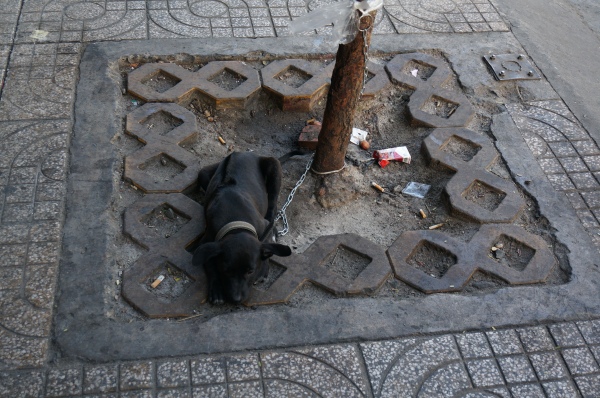
A little pup with an obvious eye infection and limp, chained up outside its house. It was panting and covered in its own saliva. I gave it some water in my bag, it was thirsty and drank more than I expected.
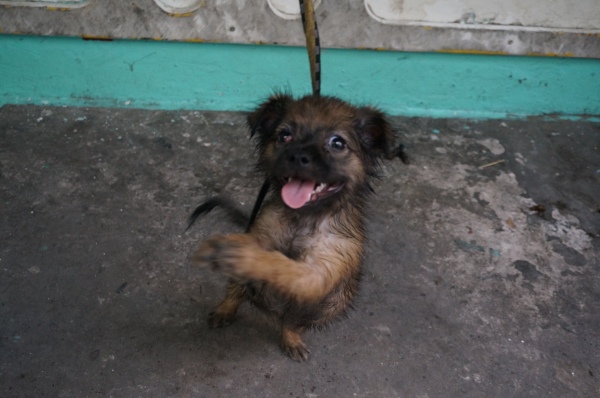
This is an example of a guard dog chained to a front gate. I don’t think they deter thieves, as much as they make some noise if people come to the door. I see dogs left like this all the time outside homes and businesses.
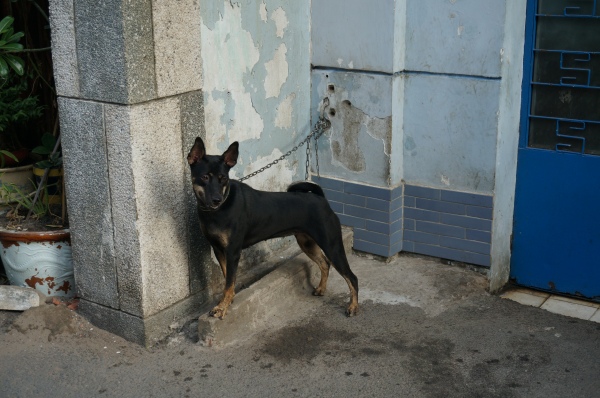
These dogs are obviously given food and water, but in all my time in Sai Gon, I’ve only seen a handful of dogs being exercised on a leash. Most dogs walk around the streets by themselves or don’t walk at all. When I’ve asked, people say that they chain up their dogs so they don’t run onto the street or get snatched by dog thieves who sell them to the dog meat trade.
This is reasonable, I suppose. But just because you are protecting a dog from a potential, terrible situation doesn’t mean that you can’t provide adequate care and attention. To say that there are dogs that are treated worse does not mean that dogs shouldn’t be treated better. Being neglected is also harmful.
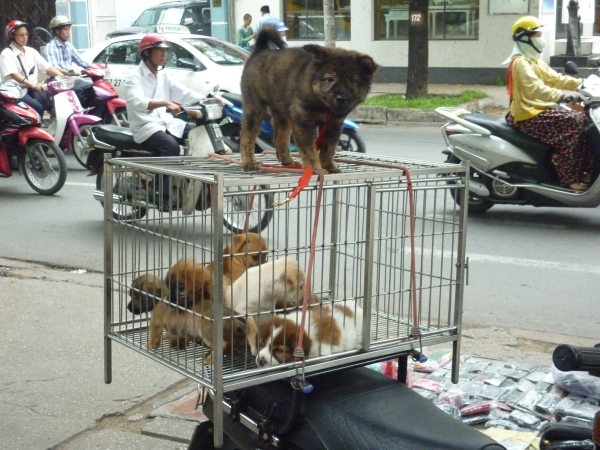
*There are some really terrific pet owners in Viet Nam look after their animals beautifully and provide them with food, water, shelter, leadership, exercise, grooming, training, veterinary care, companionship and protection. I also understand that not all owners live in ideal situations, but they still do the best they can for their animals. Looking after animals is a lifelong commitment, which can be difficult, time consuming and expensive. But it can also be one of the most rewarding and loving relationships you will experience.
**I understand that meat comes from living creatures that are slaughtered, but while there are regulations for slaughtering cattle, sheep and poultry, there are none for dogs. It is common for dogs to be bludgeoned, burned, hung, or stabbed to death; in full view of a cage of terrifying dogs waiting their turn. There are dozens of examples of it online if you don’t want to sleep peacefully again.Posted in Asia, Culture, Dog, Expat, Viet Nam, VietnamTagged Animal Cruelty, Animal Welfare, Asia, Culture, Dog, Expat, HCMC, Ho Chi Minh City, Phu Quoc Ridgeback Dog, Viet Nam, Vietnam13 Comments
Improv
I stop by the supermarket on the way home from work.
My local supermarket is a fairly standard, western-style affair with air-conditioning and florescent lights. If I don’t look too closely, I feel as though I am back in my country for a few moments as I walk in the door. But as I stride past the aquariums overcrowded with live, gasping fish and rows of pigs’ feet, my nostalgia extinguishes.
I’ve run out of laundry detergent and walk over it find some. There are a bewildering array of options; I settle in and start running my eyes across the brightly coloured bags. A store employee notices that I’ve been staring at the laundry detergent for some time and decides that it must be because I don’t know what I’m looking at. With most products in the supermarket she’d be right but in this instance the pictures of sudsy clothes tumbling in washing machines on the bags leads me to make a deduction I was reasonably confident in. She gestures to the bags of laundry detergent and mimes washing clothes with her hands; I watch for a moment and admire her perfect use of non-verbal communication. I nod and begin to copy her. We wash our imaginary clothes together in aisle 5, smiling at each other in perfect accord. I’ve almost finished washing my make-believe underpants when she is finally satisfied that I understand the use of the products on the shelf and leaves me to my deliberation. I sniff several bags of laundry detergent until I find the one that will make my clothes smell like a wildflower meadow after rain and place it in my basket.
I remember that I’m down to one roll of toilet paper at home and head in the direction to get some more. I stop suddenly when I see my new friend next to the rolls. Probably best to skip that particular improv session; I’ll come back for them tomorrow.
This is not to say that I didn’t really appreciate that woman’s efforts to help me and everyone else that has gone above and beyond to aid this hapless stranger in a strange land. I’ve lost count of the number of times people communicated with me through stilted English and French, mime, pointing, drawing, and once, animal noises. Thank you for learning more of my language than I have of yours and for your patience in the face of my ignorance.



